Remote-Sensing Estimation of Upwelling-Frequent Areas in the Adjacent Waters of Zhoushan (China)
Abstract
1. Introduction
2. Materials and Methods
2.1. Study Area
2.2. Data
2.2.1. ESA SST
2.2.2. GHRSST and MODIS SST
2.2.3. Wind Data
2.3. Method
2.3.1. An Upwelling Edge Detection Algorithm Based on Temperature Gradient
2.3.2. The Statistical Method and Probability Calculation for the Upwelling Centers and Core Area in Zhoushan Upwelling
3. Results
3.1. 28-Year Average SST Distribution
3.2. 1989–2016, 28-Year UPI Change
3.3. 28-Year Monthly Average Upwelling Center
3.4. The Probability of Daily Center Position and Core Area Position for Each Month from April to September in 28 Years
3.5. 28-Year Daily Center Position and Core Area Position Probability
4. Discussion
4.1. Winter Upwelling
4.2. Comparison of Upwelling Feature Extraction Results from MODIS and ESA SST Data Based on Algorithms
4.3. Zhoushan Upwelling and Yangtze River Estuary Upwelling
5. Conclusions
Author Contributions
Funding
Institutional Review Board Statement
Informed Consent Statement
Data Availability Statement
Acknowledgments
Conflicts of Interest
References
- Ajith Joseph, K.; Jayaram, C.; Nair, A.; George, M.S.; Balchand, A.N.; Pettersson, L.H. Remote sensing of upwelling in the Arabian Sea and adjacent near-coastal regions. In Remote Sensing of the Asian Seas; Springer: Cham, Switzerland, 2019; pp. 467–483. [Google Scholar]
- Jebri, F.; Srokosz, M.; Raitsos, D.E.; Jacobs, Z.L.; Sanchez-Franks, A.; Popova, E. Absence of the Great Whirl giant ocean vortex abates productivity in the Somali upwelling region. Commun. Earth Environ. 2024, 5, 20. [Google Scholar] [CrossRef]
- Mao, H.L.; Ren, Y.W.; Sun, G.D. Preliminary analysis of summer hydrographic characteristics and water masses in the southern Huanghai Sea and northern East China Sea. Stud. Mar. Sin. 1964, 1, 23–77. [Google Scholar]
- Pan, Y.Q.; Cao, X.Z.; Xu, J.P. A preliminary investigation of the cause and characteristics of the upwelling front zone off Zhejiang. Trans. Oceanol. Limnol. 1982, 3, 1–7. [Google Scholar]
- Xu, J.P.; Cao, X.Z.; Pan, Y.Q. Evidence for the coastal upwelling off Zhejiang. Trans. Oceanol. Limnol. 1983, 4, 17–25. [Google Scholar]
- Lou, X.; Shi, A.; Xiao, Q.; Zhang, H. Satellite observation of the Zhejiang Coastal upwelling in the East China Sea during 2007–2009. In Remote Sensing of the Ocean, Sea Ice, Coastal Waters, and Large Water Regions; SPIE: Bellingham, WA, USA, 2011; Volume 8175, pp. 454–460. [Google Scholar]
- Hu, M.N.; Zhao, C.F. Long-time observation of upwelling in the Zhoushan Islands and adjacent seas during the summer season. Period. Ocean Univ. China 2007, 1, 235–240. [Google Scholar]
- Yang, J.; Zhang, D.; Chen, Y.; Fan, W.; Liang, H.; Tan, M. Feasibility analysis and trial of air-lift artificial upwelling powered by hybrid energy system. Ocean Eng. 2017, 129, 520–528. [Google Scholar] [CrossRef]
- Hu, M.; Zhao, C. Upwelling in Zhejiang coastal areas during summer detected by satellite observations. J. Remote Sens. Beijing 2008, 12, 304. [Google Scholar]
- Hu, J.; Wang, X.H. Progress on upwelling studies in the China seas. Rev. Geophys. 2016, 54, 653–673. [Google Scholar] [CrossRef]
- Ekman, V.W. On the Influence of the Earth’s Rotation on Ocean-Currents; University Microfilms, INC.: Ann Arbor, MI, USA, 1905. [Google Scholar]
- Jing, Z.Y.; Hua, Z.L.; Qi, Y.Q.; Cheng, X.H. Numerical study on the coastal upwelling and its seasonal variation in the East China Sea. J. Coast. Res. 2007, 50, 555–563. [Google Scholar] [CrossRef]
- Yin, W.; Ma, Y.; Wang, D.; He, S.; Huang, D. Surface Upwelling off the Zhoushan Islands, East China Sea, from Himawari-8 AHI Data. Remote Sens. 2022, 14, 3261. [Google Scholar] [CrossRef]
- Lü, X.; Qiao, F.; Xia, C.; Zhu, J.; Yuan, Y. Upwelling off Yangtze River estuary in summer. J. Geophys. Res. Ocean. 2006, 111, C11S08. [Google Scholar] [CrossRef]
- Lü, X.; Qiao, F.; Xia, C.; Yuan, Y. Tidally induced upwelling off Yangtze River estuary and in Zhejiang coastal waters in summer. Sci. China. Earth Sci. 2007, 50, 462. [Google Scholar] [CrossRef]
- Zhu, J. Dynamic mechanism of the upwelling on the west side of the submerged river valley off the Changjiang mouth in summertime. Chin. Sci. Bull. 2003, 48, 2754–2758. [Google Scholar] [CrossRef]
- Pei, S.; Shen, Z.; Laws, E.A. Nutrient Dynamics of the Upwelling Area in the Changjiang Estuary. In Studies of the Biogeochemistry of Typical Estuaries and Bays in China; Springer: Berlin/Heidelberg, Germany, 2020; pp. 105–124. [Google Scholar]
- Pei, S.; Shen, Z.; Laws, E.A. Nutrient dynamics in the upwelling area of Changjiang (Yangtze River) estuary. J. Coast. Res. 2009, 25, 569–580. [Google Scholar] [CrossRef]
- Tseng, Y.F.; Lin, J.; Dai, M.; Kao, S.J. Joint effect of freshwater plume and coastal upwelling on phytoplankton growth off the Changjiang River. Biogeosciences 2014, 11, 409–423. [Google Scholar] [CrossRef]
- Budiman, A.S.; Bengen, D.G.; Nurjaya, I.W.; Arifin, Z.; Ismail, M.F.A. A comparison of the three upwelling indices in the South Java sea shelf. CMU J. Nat. Sci 2022, 21, e2022044. [Google Scholar] [CrossRef]
- Yang, S.; Mao, X.; Jiang, W. Interannual variation of coastal upwelling in summer in Zhejiang, China. Period. Ocean Univ. China 2020, 50, 1–8. [Google Scholar]
- Yin, W.; Huang, D. Short-term variations in the surface upwelling off northeastern Taiwan observed via satellite data. J. Geophys. Res. Ocean. 2019, 124, 939–954. [Google Scholar] [CrossRef]
- Varela, R.; Rodríguez-Díaz, L.; de Castro, M.; Gómez-Gesteira, M. Influence of Canary upwelling system on coastal SST warming along the 21st century using CMIP6 GCMs. Glob. Planet. Chang. 2022, 208, 103692. [Google Scholar] [CrossRef]
- Xu, Q.; Zhang, S.; Cheng, Y.; Zuo, J. Interannual feature of summer upwelling around the Zhoushan Islands in the East China Sea. J. Coast. Res. 2017, 33, 125–134. [Google Scholar] [CrossRef]
- Wong, G.T.; Hung, C.C.; Gong, G.C. Dissolved iodine species in the East China Sea—A complementary tracer for upwelling water on the shelf. Cont. Shelf Res. 2004, 24, 1465–1484. [Google Scholar] [CrossRef]
- Cai, L.; Yu, M.; Yan, X.; Zhou, Y.; Chen, S. HY-1C/D Reveals the Chlorophyll-a Concentration Distribution Details in the Intensive Islands’ Waters and Its Consistency with the Distribution of Fish Spawning Ground. Remote Sens. 2022, 14, 4270. [Google Scholar] [CrossRef]
- Chen, C.; Zhu, J.; Beardsley, R.C.; Franks, P.J. Physical-biological sources for dense algal blooms near the Changjiang River. Geophys. Res. Lett. 2003, 30, 1515. [Google Scholar] [CrossRef]
- Merchant, C.J.; Embury, O.; Bulgin, C.E.; Block, T.; Corlett, G.K.; Fiedler, E.; Good, S.A.; Mittaz, J.; Rayner, N.A.; Berry, D.; et al. Satellite-based time-series of sea-surface temperature since 1981 for climate applications. Sci. Data 2019, 6, 223. [Google Scholar] [CrossRef] [PubMed]
- Good, S.; Fiedler, E.; Mao, C.; Martin, M.J.; Maycock, A.; Reid, R.; Roberts-Jones, J.; Searle, T.; Waters, J.; While, J.; et al. The current configuration of the OSTIA system for operational production of foundation sea surface temperature and ice concentration analyses. Remote Sens. 2020, 12, 720. [Google Scholar] [CrossRef]
- Xiao, T.; Yin, W.; Feng, J.; Liu, Y.; Wong, K.; Tsou, J.Y.; Zhang, Y. Satellite-Based Analysis of Surface Upwelling in the Sea Adjacent to Zhoushan Islands in China. J. Mar. Sci. Eng. 2023, 11, 511. [Google Scholar] [CrossRef]
- Huang, Q.; Xu, Q.; Zhang, S.; Cheng, Y. Study of coastal upwelling around Zhoushan Islands based on satellite measurements and numerical model. In Proceedings of the 2016 Progress in Electromagnetic Research Symposium (PIERS), Shanghai, China, 8–11 August 2016; pp. 4764–4768. [Google Scholar]
- Tang, R.; Cai, L.; Yan, X.; Ye, X.; Xu, Y.; Yin, J. Study of the Response of Environmental Factors of the Coastal Area in Zhoushan Fishery to Typhoon In-fa Based on Remote Sensing. Remote Sens. 2023, 15, 3349. [Google Scholar] [CrossRef]
- Qiao, F.; Yang, Y.; Lü, X.; Xia, C.; Chen, X.; Wang, B.; Yuan, Y. Coastal upwelling in the East China Sea in winter. J. Geophys. Res. Ocean. 2006, 111, C11S06. [Google Scholar] [CrossRef]
- Hu, D.X.; Lu, L.H.; Ding, Z.X.; Xiong, Q.C.; Sun, S.C. A study of coastal upwelling off SE China. Kexue Tongbao (Sci. Bull.) 1980, 25, 159–163. [Google Scholar]
- Wu, H.; Shen, J.; Zhu, J.; Zhang, J.; Li, L. Characteristics of the Changjiang plume and its extension along the Jiangsu Coast. Cont. Shelf Res. 2014, 76, 108–123. [Google Scholar] [CrossRef]
- Fernández-Nóvoa, D.; Costoya, X.; DeCastro, M.; Gómez-Gesteira, M. Influence of the mightiest rivers worldwide on coastal sea surface temperature warming. Sci. Total Environ. 2021, 768, 144915. [Google Scholar] [CrossRef] [PubMed]
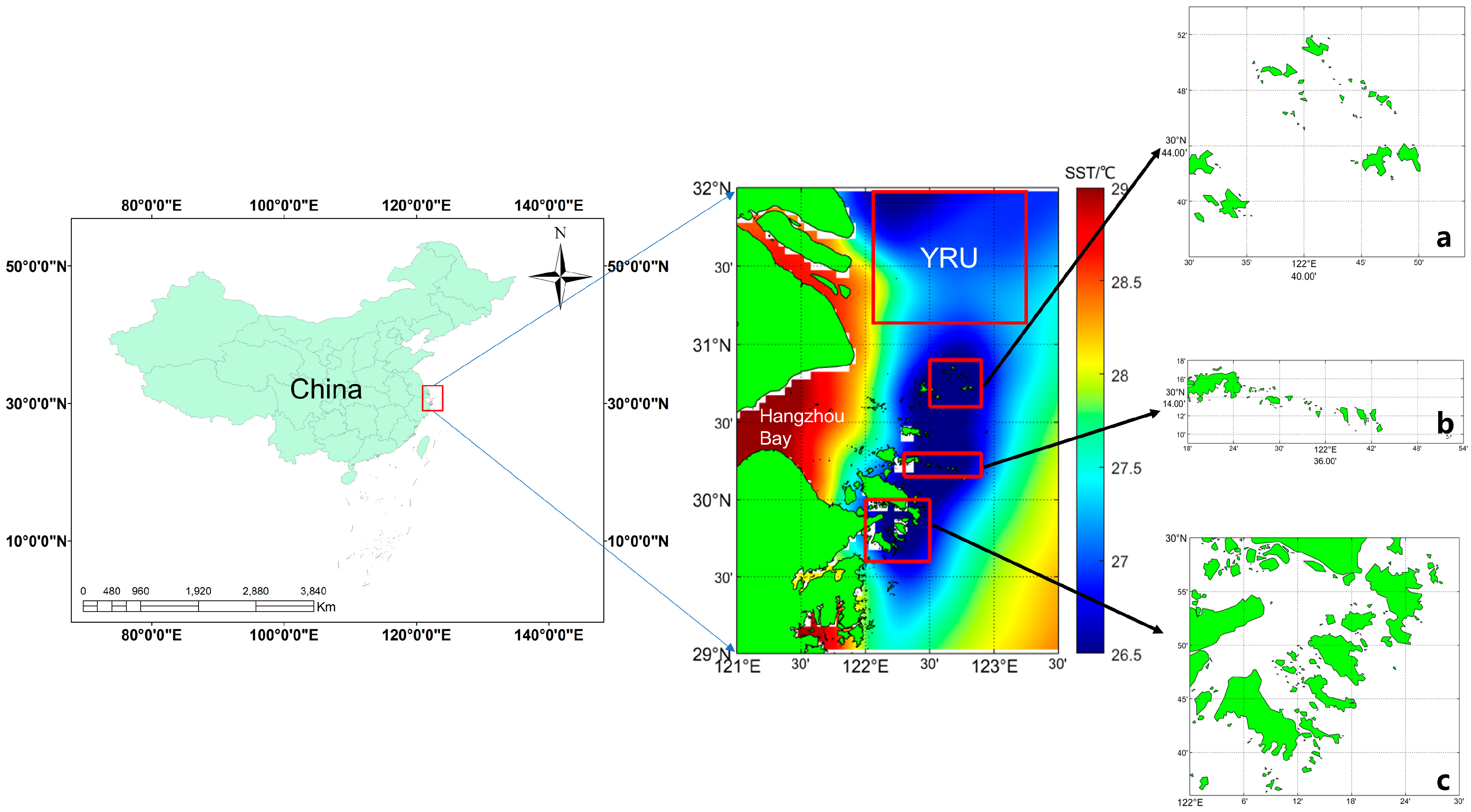



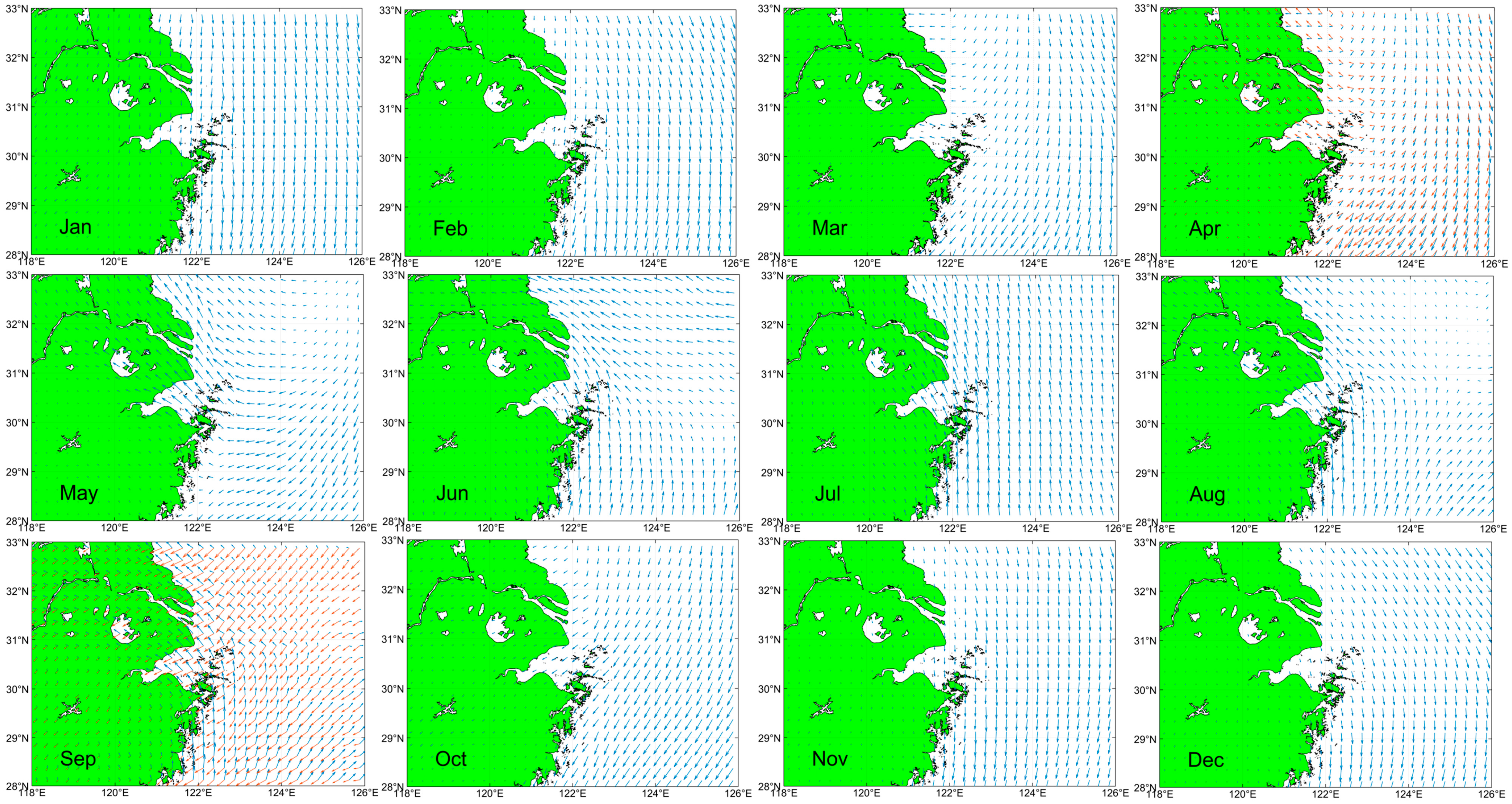


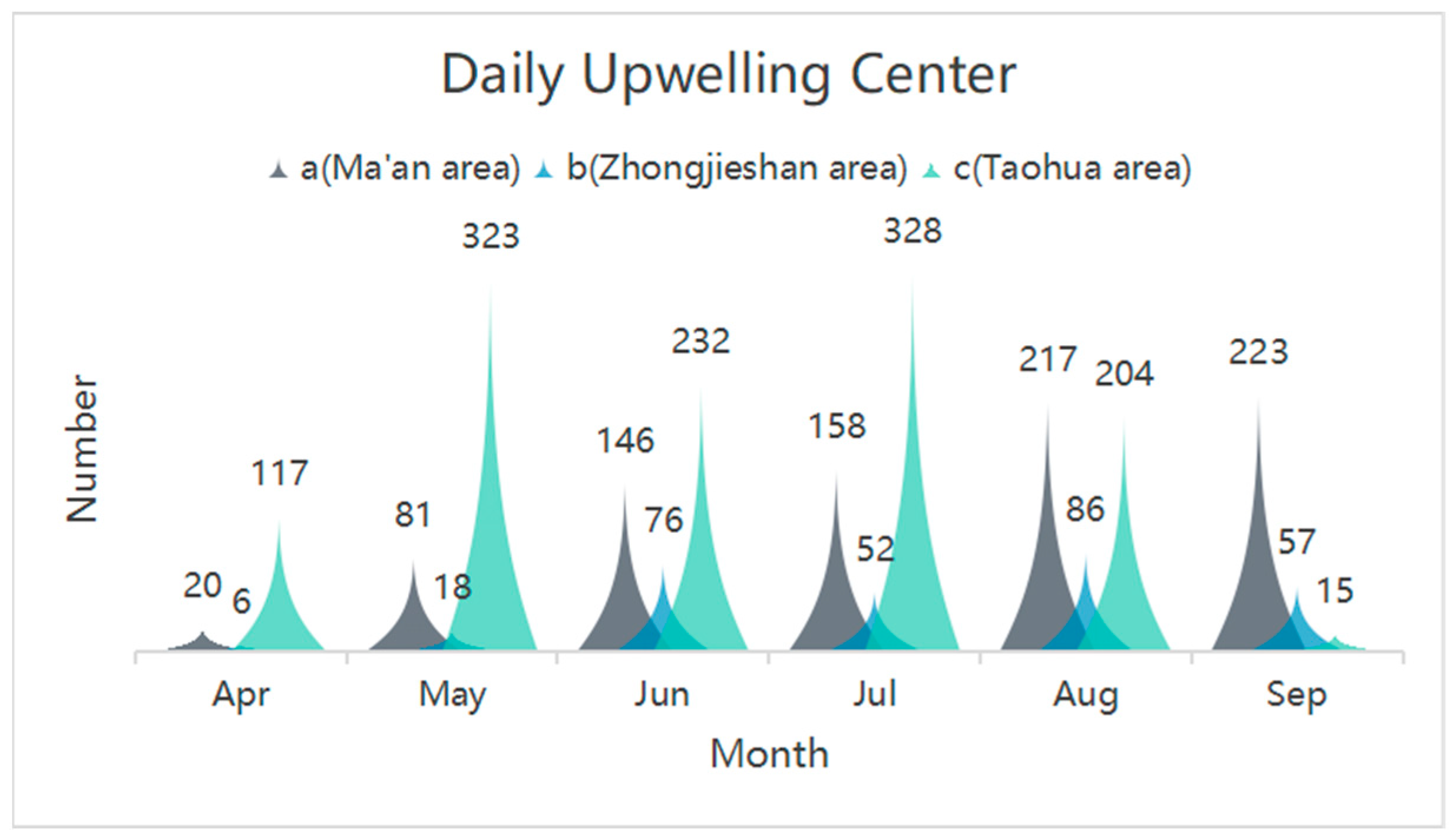
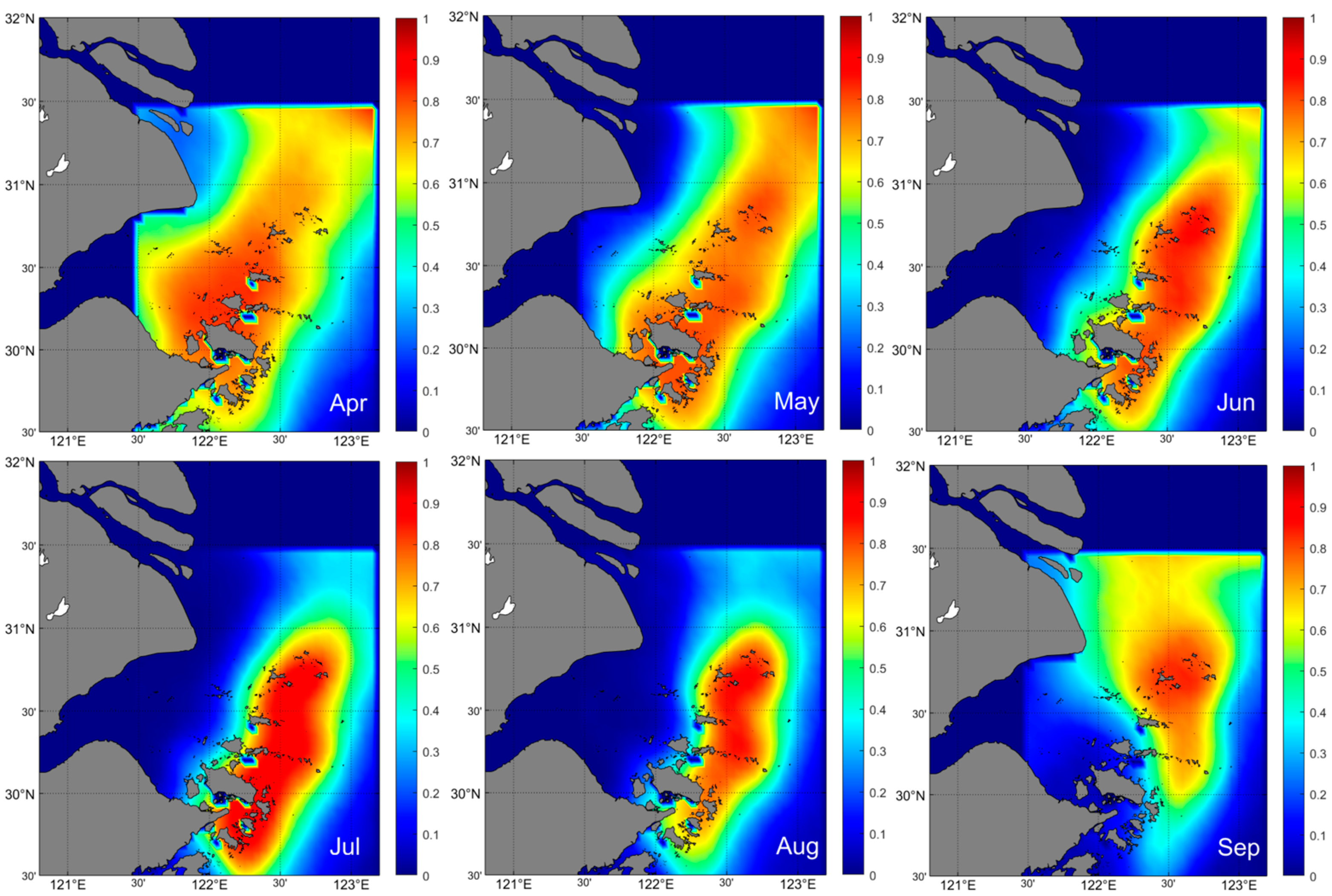



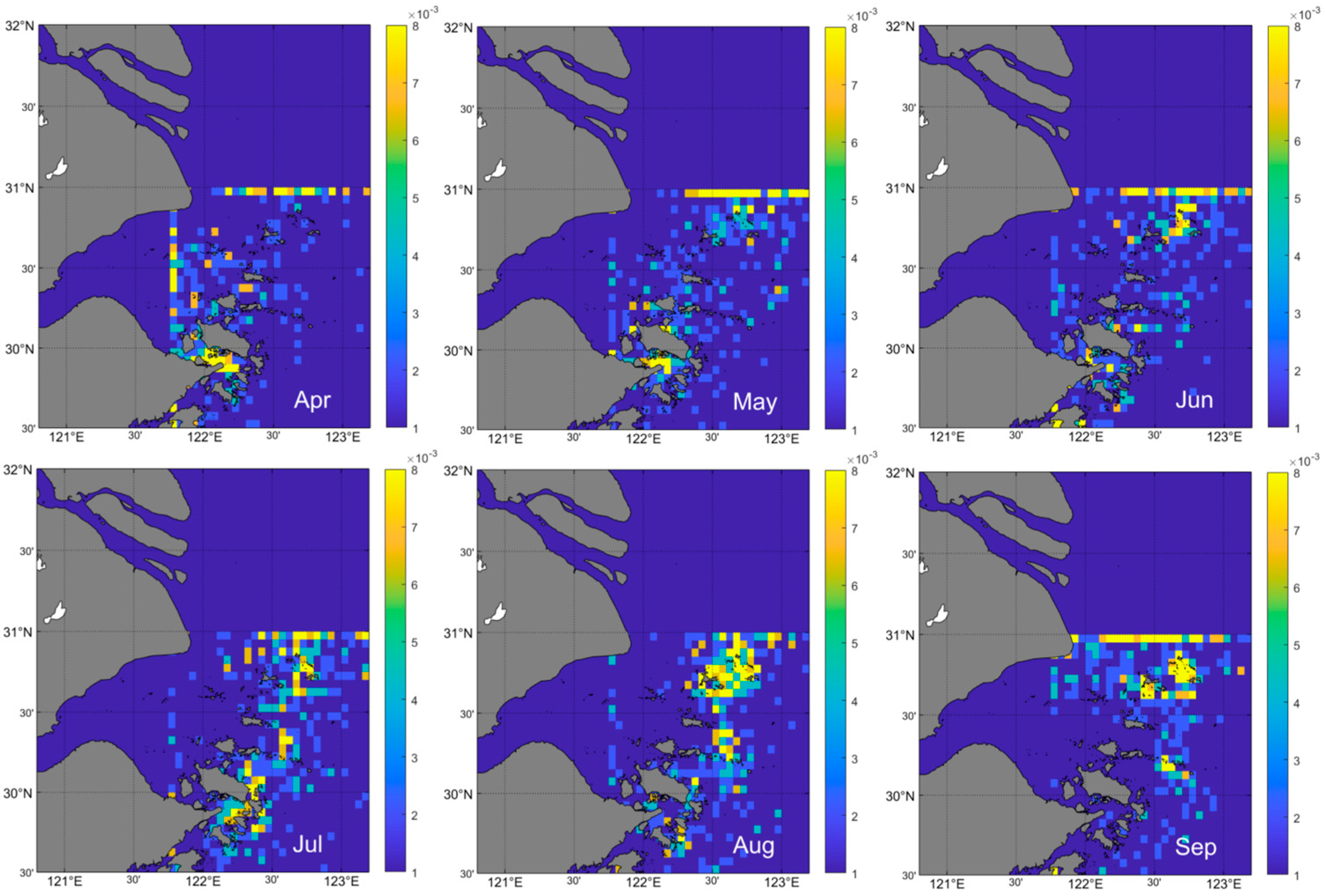
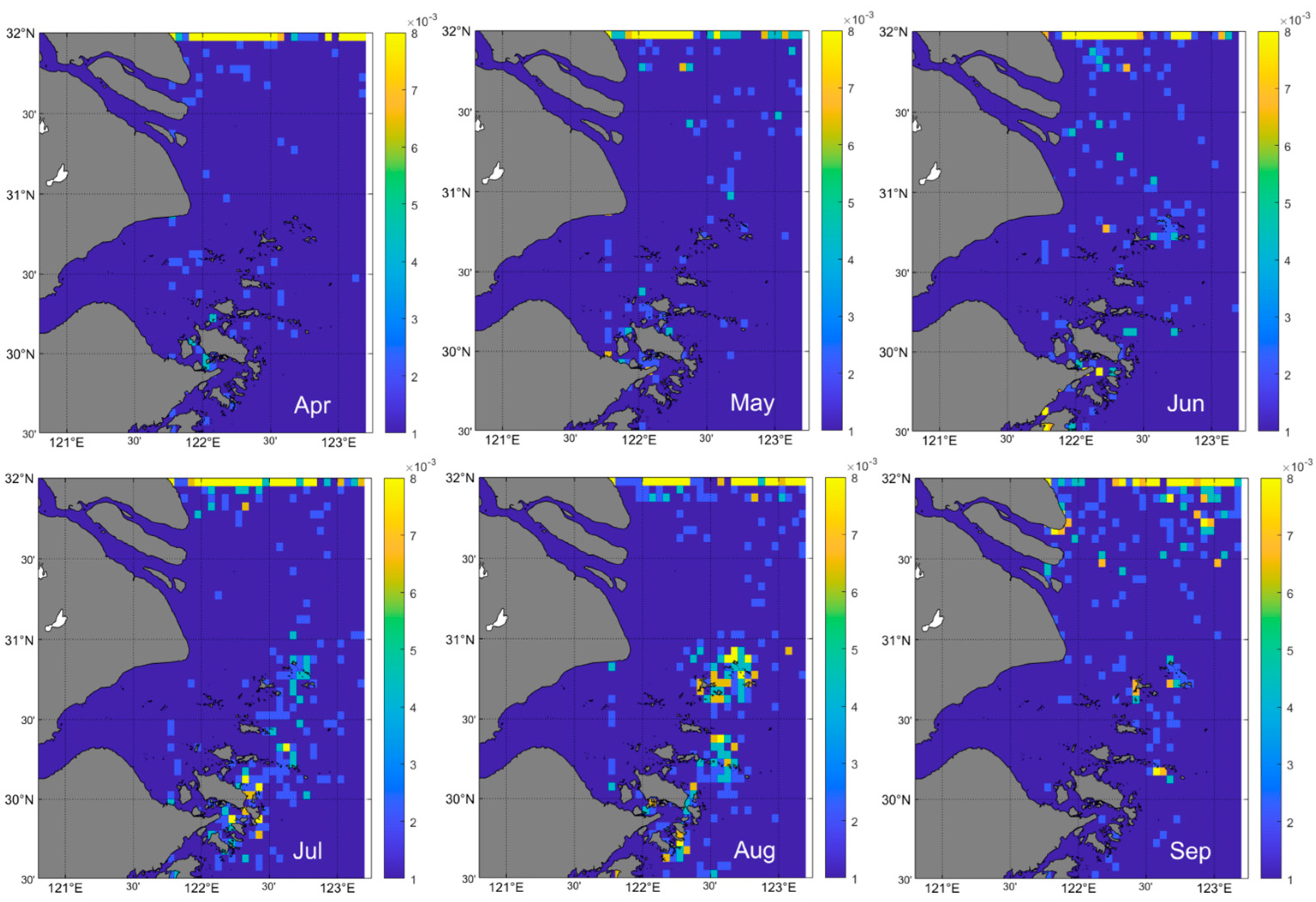
| Period/Month | Apr | May | Jun | Jul | Aug | Sep |
|---|---|---|---|---|---|---|
| 1989–1998 | 0.94 | 1.19 | 1.27 | 1.85 | 1.55 | 0.96 |
| 1999–2008 | 1.10 | 1.17 | 1.31 | 1.78 | 1.52 | 0.89 |
| 2009–2016 | 1.00 | 1.12 | 1.03 | 1.79 | 1.59 | 0.87 |
| Period/Month | Apr | May | Jun | Jul | Aug | Sep |
|---|---|---|---|---|---|---|
| 1989–1998 | 18,948 | 17,355 | 14,939 | 12,629 | 10,245 | 12,626 |
| 1999–2008 | 21,164 | 19,759 | 16,037 | 13,047 | 10,384 | 12,957 |
| 2009–2016 | 19,448 | 17,830 | 13,352 | 13,098 | 12,139 | 13,978 |
| 1989–2016 | 19,883 | 18,350 | 14,878 | 12,912 | 10,836 | 13,131 |
Disclaimer/Publisher’s Note: The statements, opinions and data contained in all publications are solely those of the individual author(s) and contributor(s) and not of MDPI and/or the editor(s). MDPI and/or the editor(s) disclaim responsibility for any injury to people or property resulting from any ideas, methods, instructions or products referred to in the content. |
© 2024 by the authors. Licensee MDPI, Basel, Switzerland. This article is an open access article distributed under the terms and conditions of the Creative Commons Attribution (CC BY) license (https://creativecommons.org/licenses/by/4.0/).
Share and Cite
Xiao, T.; Feng, J.; Qiu, Z.; Tang, R.; Zhao, A.; Wong, K.; Tsou, J.Y.; Zhang, Y. Remote-Sensing Estimation of Upwelling-Frequent Areas in the Adjacent Waters of Zhoushan (China). J. Mar. Sci. Eng. 2024, 12, 1085. https://doi.org/10.3390/jmse12071085
Xiao T, Feng J, Qiu Z, Tang R, Zhao A, Wong K, Tsou JY, Zhang Y. Remote-Sensing Estimation of Upwelling-Frequent Areas in the Adjacent Waters of Zhoushan (China). Journal of Marine Science and Engineering. 2024; 12(7):1085. https://doi.org/10.3390/jmse12071085
Chicago/Turabian StyleXiao, Teng, Jiajun Feng, Zhongfeng Qiu, Rong Tang, Aibo Zhao, Kapo Wong, Jin Yeu Tsou, and Yuanzhi Zhang. 2024. "Remote-Sensing Estimation of Upwelling-Frequent Areas in the Adjacent Waters of Zhoushan (China)" Journal of Marine Science and Engineering 12, no. 7: 1085. https://doi.org/10.3390/jmse12071085
APA StyleXiao, T., Feng, J., Qiu, Z., Tang, R., Zhao, A., Wong, K., Tsou, J. Y., & Zhang, Y. (2024). Remote-Sensing Estimation of Upwelling-Frequent Areas in the Adjacent Waters of Zhoushan (China). Journal of Marine Science and Engineering, 12(7), 1085. https://doi.org/10.3390/jmse12071085








